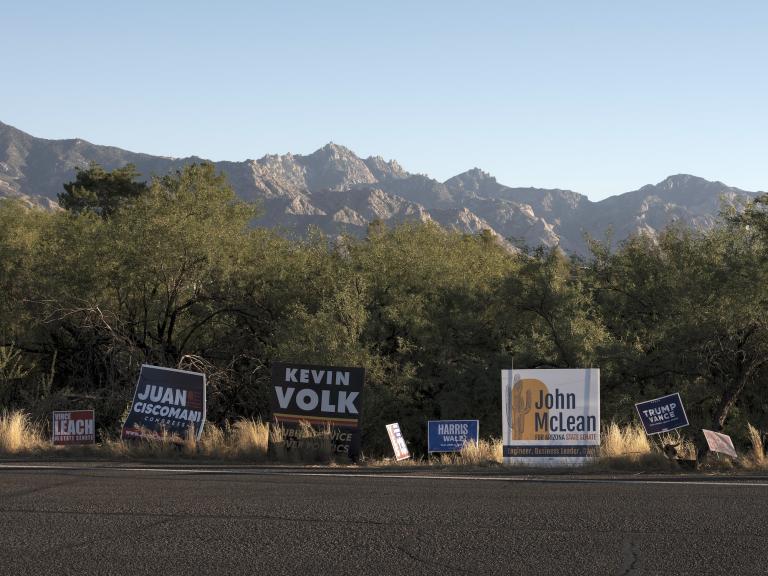I heard that George Bush told New Orleans Mayor Ray Nagin the city could be remade into “a shining example for the whole world.” If Bush did say that, it surely wasn’t an environmentally sound renaissance he had in mind. But that is precisely what is needed.
Call it Eco New Orleans. It should encompass not just the city, but the other places blasted by Katrina and by FEMA’s impressively incompetent response. The Eco New Orleans I’m talking about should extend scores of miles in every direction. It should be a place attuned to the definition of sustainable development put forth by the U.N.’s Brundtland Commission: “Meeting the needs of the present without compromising the ability of future generations to meet their own needs.”

Which way to go?
Some estimates put the cost of rebuilding the city and its neighbors at $150 billion — seven times more than the total amount the feds spent on the nation’s 10 most expensive previous natural disasters. Eco New Orleans would cost even more, take longer, and require forming a plethora of public-private enterprises and overcoming immense ideological obstacles. But if we as Americans are unwilling to spend the time and money to rebuild New Orleans and the rest of the Gulf Coast with environmental concerns taking a front seat, then we’re as self-interestedly myopic as the administration that couldn’t pry itself out of vacation mode to save people’s lives.
I’m not saying we can, or should, start tomorrow — the ongoing human disaster caused by Katrina must be taken care of first. Nor do I seek imposition of a utopian ideal that ignores the region’s unique culture, history, and atmosphere. Building Eco New Orleans would demand an innovative politics not only to educate communities about the benefits of an environmentally sound approach, but also to spur them to provide input into how exactly to implement it. It would call for, to use a phrase from my youth, “participatory democracy.”
Much can be done to shape the damaged Gulf Coast into a model for others to emulate, modifying it for their own circumstances. I have no blueprint, just an outline of ideas that other people have been thinking about far longer than I. Here are a few places to start:
Fully fund “Coast 2050.” This wish list of restoration projects, first put together in the late 1990s, carries an estimated price tag of $14 billion over 30 years. The Bush administration has reliably opposed funding for it.
Because wetlands act as a storm buffer, those already lost to erosion and subsidence probably worsened Hurricane Katrina’s destruction. About 90 percent of America’s coastal wetlands loss each year occurs in Louisiana: 1,900 square miles since 1932, an additional 700 square miles by 2050, scientists say. If these resources disappear at even a fraction of this pace, immense harm will be caused to human populations, infrastructure, the seafood industry, fisheries, and wildlife.
Coast 2050 is no radical proposal, even though the motivation behind it is grim. Like any plan assembled by diverse stakeholders, it’s a compromise. As its creators say: “Because natural processes created the highly productive wetlands in coastal Louisiana, reestablishment of these processes is essential to achieve sustainability. Reestablishment does not imply controlling nature … [or] a return of the coastal system to a pristine condition, because too much has changed for that to occur. The intent is to design restoration strategies based on ecological principles so the future coast will have the productivity and other desirable features of a highly valued natural system.”
Upgrade oil refineries. Several refineries have been temporarily shut down by Katrina, but they’ll be back. When operational, these facilities are environmental disasters, founded on outdated technology and producing a heavy output of pollution.
No hydrocarbon refining process can ever be truly green. But greener refineries would install shielded pipes and conduits; isolated and double-barrier-protected towers, tanks, and reservoirs; and multiple pressure-relief and blowout prevention devices. Greener refineries would initiate more efficient processing and capture effluents and reaction products better. Greener would require better scrubbing and filtering. Greener would involve better oversight, maintenance, training, and siting.
Never keen on enhancing environmental controls of any sort, President Bush has proposed that new refineries be constructed on closed military bases with no such modifications. Getting the administration to press even minor upgrades for existing refineries would be no easy matter.
Curtail oil and gas drilling in the Delta. Since Katrina struck, many people have taken note of last year’s almost supernaturally prescient piece “Gone With the Water” in National Geographic. Joel K. Bourne Jr. described a New Orleans-area catastrophe that could have been yanked from the recent headlines.
He also outlined the conclusions of Bob Morton, a former petroleum geologist now with the U.S. Geological Survey. Morton noticed Louisiana’s wetland losses reached a peak during or just after the period of intensive oil and gas production in the 1970s and early 1980s. He believes that removing millions of barrels of oil, trillions of cubic feet of natural gas, and the huge amounts of saline water found within petroleum deposits caused subsurface pressure to drop, which in turn caused nearby faults to slip and the land above them to subside.
“When you stick a straw in a soda and suck on it, everything goes down,” Morton told Bourne. “That’s very simplified, but you get the idea.” The oil industry argues against Morton’s theory, but neither it nor its consultants have been able to disprove it.
Support renewable energy. Louisiana (and Alabama and Mississippi) could all benefit from retooling their practically invisible state energy departments. Although each gives lip service to conservation, few moves have been made toward developing a renewable-energy, conservation-oriented mind-set among citizens, or assisting those citizens who already “get it.”

A fountain of ideas.
Using the experiences of other states and going a few steps farther, Eco New Orleans should be outfitted with solar-power systems, gas microturbines, combustion turbines, wind turbines, fuel cells, and cogeneration systems, so the region can begin the march toward independence from fossil fuels that is essential for the planet’s long-term health. Much of this could be accomplished with tax breaks to consumers, manufacturers, and developers. Eco New Orleans should also put considerable effort into community outreach to teach people to become energy smart. Less affluent consumers should have access to subsidies so they can make the change along with everyone else.
Adopt “smart growth” concepts as regional policy. The smart-growth movement focuses on environment in the broadest possible way: quality of life, design, economics, health, housing, and transportation. Principles guiding smart growth include developing a range of housing types; creating walkable, architecturally distinctive neighborhoods; encouraging community participation in decision making; opting for mixed land uses; making development decisions “predictable, fair, and cost-effective”; preserving farmland and open space; providing for a variety of transportation modes; adopting compact building styles; and directing development toward existing communities.
The key to making smart growth work in Eco New Orleans would be making sure it doesn’t merely mean gentrification, a greened-up version of urban renewal that forces out the poor.
Rebuild with Green Communities in mind. Green Communities, a partnership between the Enterprise Foundation and the Natural Resources Defense Council, is a five-year, $555 million program dedicated to building more than 8,500 environmentally healthy dwellings for low-income residents nationwide. Rehabilitation of rental and owner-occupied dwellings is also part of the agenda. Support for the projects — like Seattle’s new 50-unit Denny Park Apartments — comes from housing authorities, corporations, and private foundations, as well as the Enterprise Social Investment Corporation.
Before Katrina, New Orleans was the fifth most densely populated city in America, filled with impoverished neighborhoods that would benefit from an expansion of the Green Communities program, or at least an imitation of it. In addition to those 8,500 green units nationwide, why not 85,000 units for Eco New Orleans?
Establish green building standards. More affluent dwellings in Eco New Orleans should also be built or rehabilitated with more than a modest concern for environmental effects. Regulations based on a system similar to LEED that assigns “points” for, among other things, energy efficiency, use of green materials, siting angles, landscaping, window glazing, and the like could make a big difference region-wide. New housing and rehabs that reach a minimum-point threshold would be the only ones approved, but nobody would be required to follow a strict architectural formula.
None of this is simple. For one thing, I’ve left out a lot of issues, both big and small: Cancer Alley, mass transit, park development, sewage treatment, and zoning issues, to name a few. And Eco New Orleans cannot, obviously, spring up full-grown. No great changes are ever accomplished overnight. But someday all cities must be “eco,” or they will be dead. New Orleans and its battered neighbors have a chance to be pioneers.

